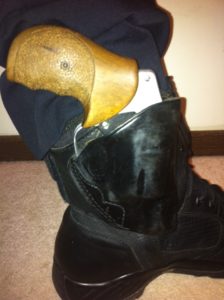Written by: Greg Ellifritz
Have you ever thought about using a backup gun to arm a companion who may not be inclined to carry a weapon himself? What about arming a person who isn’t legal to carry in a particular environment. As a cop, I can carry guns almost everywhere. My girlfriend (who is well trained) cannot carry in the same places I can with her CCW permit. Should I carry a gun so that I can arm her if she isn’t carrying?
I think the idea is worthy of some exploration.
Like many of you, I had generally discounted the strategy of being another person’s holster…until one day I was thrust into a situation where the idea didn’t seem so crazy.
I was working as the training officer for my police department. My training duties that day consisted of taking a new hire officer to the range, issuing him his firearm and doing some shooting drills. It was the officer’s first day on our police department, but he had about eight years of full time law enforcement experience with a local Sheriff’s Office, serving as a patrol officer, detective, and member of their SWAT team. He was a well- trained and capable officer.
As I was driving the new officer to the shooting range, a bank robbery call went out. An armed robber was fleeing on foot less than 1/2 mile from our location. We were the closest cops to the call, but my new guy didn’t have a gun.
I handed him my backup .38 snub revolver just as we caught sight of the fleeing robber. We both bailed out of the car and gave chase. We caught the armed robber about a minute later and I arrested him without incident….but I was glad I had a second officer with me to provide additional cover. And he wouldn’t have been able to do that without the hand off of my backup gun.
If you are considering carrying a gun for another person, there are few things to think about.
As my friend Claude Werner says:
“An implied task of this situation is developing and practicing a protocol to make sure there isn’t a negligent discharge while the weapon is being passed to them or they are accessing it from the carrier. This implied task is not as cut and dried as it might seem.“
Claude has developed a set of protocols he uses when carrying a gun for another person. Here is how he facilitates passing off the backup gun:
“* Draw weapon with right hand (I’m right handed).
* Place weapon into palm of left hand with fingers of left hand around fingers of right hand, fingers running perpendicular to each other.
* Release weapon with right hand into left hand. Barrel/slide is now in palm of left hand with fingers wrapped around trigger guard from top to bottom. This protects the trigger guard from having the other person’s finger getting into it, assuming they are right handed.
* Pass it toward the person with the muzzle pointed forward, i.e., away from both of us.
* The other takes hold of the butt of the weapon with trigger finger on top of my fingers, approximating the register position.
* Time permitting, I will ask “Got it?”
* If she feels she has a good grip, she will respond “Got it.”
* I then release my hold on the weapon and then pull my hand straight up from it so I do not sweep my hand over the muzzle.
This is also how I hand guns to other people in general and how I teach gun passing in my classes. The muzzle may be oriented in a different direction for safety.
I believe Scott Reitz teaches something similar to this with regard to gun passing. That may have been the origin of the idea, I don’t recall.”
Think about responding to/escaping from an active shooter at the shopping mall this holiday season. Wouldn’t it be better to have another armed and trained individual on scene?
If you think it’s a good idea, consider carrying an additional piece to arm someone who doesn’t carry for himself/herself.


